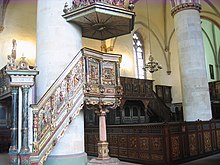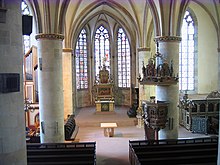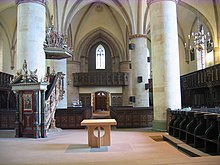St. Johannis (Herford)
St. Johannis is the Evangelical Lutheran parish church in Herford New Town, which was founded in 1220 . Since 1414 it was also the collegiate church of the secular collegiate monastery of St. Johann and Dionys, originally located in Enger . This existed until the secularization of 1802. It is not to be confused with the neighboring Catholic Church of St. John Baptist . Within the parish of Herford , the Johanniskirche belongs together with the Herford Minster and the Jakobikirche to the parish of Herford-Mitte.
history
Presumably on the site of an older cemetery and a chapel, a new church was built by Herford Abbey from 1240 , which a short time later was called the parish church for the new town.
Because of the unsafe situation, the monastery of St. Dionys von Enger was moved to the fortified Herford in 1414 ; The Johanniskirche became the collegiate church. Back then, the canons not only brought the famous Dionysius treasure with Charlemagne's duties to Widukind to Herford, but also the remains of the Saxon Duke Widukind, which rested in the Johanniskirche until 1810. Today the tasks are in the Berlin Museum of Decorative Arts . Widukind's (supposed) bones were brought back to the Engeraner collegiate church .
Due to the new function as a collegiate church, a choir screen ( rood screen ) was built in the church between the area of the canons and the laity. In addition, side altars were erected to allow the numerous priests to quiet masses and prayers. The tower was also raised, making it Herford's tallest.
During the Reformation , numerous objects in the monastery and church were destroyed in the course of the “Herford Iconoclasm” of 1532.
The monastery itself continued to exist as a Protestant institution. In the 18th century, the King of Prussia , the Elector of the Palatinate and the Chapter itself alternately had the right to appoint new canons if they were vacant.
The church has been a listed building since 1981 . Since 2008 it has not been heated for cost reasons.
Architecture and equipment
The Johanniskirche in its present form was built from around 1250 to 1370 in several construction phases as a Westphalian square in the Gothic style. The tower was set on fire and destroyed by flying sparks in the great city fire of 1638. The then erected 85 m high tower leaned to one side in the course of the following centuries and became known as the "leaning tower of Herford". Because of the danger of collapse, the tower helmet had to be removed in 1885 and was replaced by a new 80 m high. However, the structure continued to deteriorate. In addition, the construction of the municipal sewerage system led to a serious drop in the water table, causing the oak piles of the foundation to rot. As a result, the tower had to be completely dismantled, re-founded and rebuilt between 1906 and 1910. The new tower was built with old material and in the old form, but received one floor less (7 m) than its predecessor. It is now only 71 m high, but it is still the highest church tower in Herford.
Some of the stained glass windows, which are among the oldest in Westphalia, date from the 14th and 15th centuries and were saved from destruction in May 1940 thanks to the courageous efforts of the pastor Helmut Gaffron. The younger, unsecured windows were destroyed by vibrations caused by bombs near the church (Hämelinger Str.).
inner space
The artistically valuable interior is from the 16th and 17th centuries. The carved wooden office chairs of the craftsmen's guilds of the Neustadt are characteristic. The baroque pulpit was donated by the mayor Daniel Pöppelmann, a direct ancestor of Matthäus Daniel Pöppelmann, who was born in Herford in 1662 .
organ
The organ was built in 1955 by the organ builder Gustav Steinmann Orgelbau . The abrasive loading -instrument has 26 registers , on two manuals and pedals are distributed. The actions are mechanical.
|
|
|
||||||||||||||||||||||||||||||||||||||||||||||||||||||
- Coupling : II / I, I / P, II / P
Bells
Five bells hang in the tower: Bells I, II and III were made between 1639 and 1646 by the Hemony family of bell foundries , Bell IV (formerly quarter-bell) as early as 1496 and comes from Gerhard van Wou's circle . The fifth and smallest is used to strike the quarter of an hour (bell II in the tower for the hour strike) and hangs in a small opening on the eastern dial. It wasn't cast until the 1990s. The other four bells are ringing and are divided between two bell chambers; in the upper one hangs the smaller bell (originally cast as a quarter-stroke bell), in the lower one the three large bells. All four bells together only sound on special occasions. On Christmas Eve and Pentecost Sunday at 12 noon, the bells of the city of Herford will ring for 20 minutes. Bells I, II and III were under Reich monument protection and therefore did not have to be delivered during the Second World War as part of the metal donation of the German people . Bell IV, on the other hand, was requisitioned, but not - like many other bells - smashed in the tower, but transported away in one piece. By fortunate coincidences it survived the war in the Hamburg bell cemetery and was able to be brought back after 1945.
|
No. |
Name / function |
Casting year |
Caster |
Diameter (mm) |
Mass (kg) |
Percussive ( HT - 1 / 16 ) |
Belfry |
| 1 | Prayer bell | 1646 | François & Petrus Hemony | 1,504 | 2,200 | c 1 +6 | lower bell chamber |
| 2 | Fire bell (hour bell) | 1639 | 1,344 | 1,550 | d 1 +2 | ||
| 3 | Sermon bell | 1,190 | 1,000 | e 1 ± 0 | |||
| 4th | Katharina (holiday bell) | 1496 | unknown ( van Wou school) | 980 | a 1 −4 | upper bell chamber | |
| I. | Quarter-hour bell | Bell and art foundry Rincker | c 2 | Spire (east side) |
Web links
- Documents from the archives of the St. Johann and Dionys Monastery in Herford / Digital Westphalian document database (DWUD)
- St. Johannis in Herford
literature
- Helga Besche: St. Johannis in Herford (= great architectural monuments . Issue 358). Deutscher Kunstverlag, Munich / Berlin 1989
Individual evidence
- ↑ Nicolas Rügge: In the service of city and state: The council of the city of Herford and the Prussian central administration in the 18th century (= bourgeoisie. Contributions to European social history. Volume 15). Vandenhoeck & Ruprecht, Göttingen 2000, p. 28 ( online ).
- ↑ List of architectural monuments in the city of Herford (PDF; 78 kB)
- ^ Gregor Rohmann (Ed.): Bilderstreit und Bürgerstolz - Herford churches in the age of religious struggles (= Herford research. Volume 20). Publishing house for regional history, Bielefeld 2006, ISBN 978-3-89534640-8 .
- ↑ More information about the organ , accessed on September 5, 2014.
- ^ Claus Peter: Westphalia . In: Kurt Kramer (Hrsg.): The German bell landscapes. Deutscher Kunstverlag, Munich 1989, p. 55.
- ^ Brasse, Friedrich: Bells in Herford . In: Herford Association for Local History (Hrsg.): Living witness - historical considerations on bells, churches and cemeteries in Herford. Busse Seewald, Herford 1980, p. 9.
Coordinates: 52 ° 6 ′ 59.3 " N , 8 ° 40 ′ 27" E






